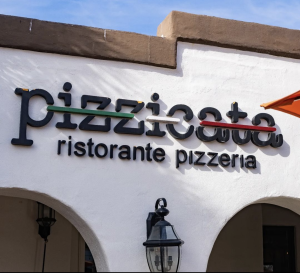-
What’s the difference between pinsa and pizza?
In the days of Ancient Rome, there originated a recipe so divine, it still graces dinner tables today. It was called pinsa, and it was revered for its incredible flavor, mesmerizing fragrance, and crisp texture.
Simply put, pinsa is a Roman-style pizza crust made with clean ingredients and hand-pressed to perfection. It’s healthier, tastier, and simply better than traditional pizza! -
Is pinsa healthy?
Health-conscious foodies rejoice with a refreshing upgrade from classic pizza crust. Pinsa is made with clean, non-GMO ingredients that are engineered to reduce bloating and discomfort. Indulge in pinsa without regret—it’s lower in calories, gluten content, and completely free of added fats and sugars!
-
What does “par-baked” mean?
When referring to pinsa crust, the term “par-baked” essentially speaks for itself—the crust has been partially baked. Although the interior of the dough is fully cooked through, the exterior lacks that golden-brown top layer. That’s where you come in. With Pinsa Romana America’s par-baked crusts, all you have to do is top with fresh ingredients, and pop in the oven for just a few minutes!
-
Is pinsa vegan?
Yes. Pinsa is made with simple ingredients: our non-GMO blend of flours, water, salt, olive oil, and yeast. Naturally, our pinsa crust is completely vegan and free of any animal products.
-
Is pinsa gluten-free?
No. Pinsa is gluten-friendly, but not 100% free of gluten. Our 48-72 hour cold fermentation process achieves the perfect maturation of the dough, breaking down the starches and glutens. In addition, the variety of flours we use in our crust recipe reduces gluten levels considerably, making the gluten less effective and less heavy in your stomach than with traditional pizza crust.
-
What toppings pair well with pinsa?
One of the best things about pinsa is that it is as versatile as it is delicious. From breakfast pinsa, to dessert pinsa, to classic margherita, pinsa is completely customizable. Top it with whatever your heart desires!
-
How long does it take to make pinsa?
Making pinsa crust from scratch is a meticulous, time-consuming process. With our
par-baked crusts, it only takes 7-10 minutes to create a delicious, authentic Italian dish. -
What is pinsa made out of?
Unlike traditional pizza crust, pinsa is made out of a non-GMO blend of wheat, rice, soy, and sourdough flours. This concoction was revolutionized to pay homage to the people of the Roman Empire.
-
What does pinsa taste like?
With a simple yet dynamic flavor profile, pinsa crust proves that you don’t have to sacrifice flavor when eating a healthier dish. It’s the perfect balance of upscale and mild—universal enough to be declared divine no matter what is sprinkled on top.
-
Where does pinsa’s recipe come from?
The Roman Empire cultivated a recipe for a healthy, versatile, and delicious flatbread. They called it pinsa, derived from the word “pinsere,” meaning “to press”. Today, pinsa is still served, slightly tweaked to please modern palates. For more information, read The Origin of Ancient Roman Pizza.
-
Why does pinsa have to be fermented?
The process of cold fermentation can be tedious, but it is necessary to create pinsa’s unique flavor and cloud-like texture. Cold fermentation’s carbon dioxide creates aroma molecules, giving the yeast more time to digest carbohydrates and develop complex flavors. This process also traps air bubbles in the dough, forming a bubbly, crisp structure.
-
Is pinsa authentic?
If you’re looking to honor traditional Italian culture and cuisine, authenticity matters. Pinsa Romana America’s crusts are as authentic as it gets in the U.S.
-
Why should I add pinsa to my menu?
Chef Carlo Pedone, owner of Pinsa Romana America, knows firsthand that chefs and restaurant owners have a lot on their plate—he did it himself for over thirty years! Practically raised in the hustle and bustle of his parent’s restaurant, Carlo is no stranger to the industry. His seasoned knowledge is where par-baked pinsa crusts were born. For more information, read The Best Par-Baked Crusts for Restaurants.
-
How do I buy par-baked pinsa crusts?
From fine dining to fast-casual, pinsa is served at all kinds of venues. Ready to grow your business? Join the Pinsa Romana America family!
-
Is pinsa artisanal?
Yes. Each crust is hand-pressed to perfection by a culinary artist. For more information, read Artisan Food: Handcrafted in Low Quantities.
-
What is the texture of pinsa?
Cold fermentation causes the pinsa crust to adopt air bubbles, creating a cloud-like texture that feels practically weightless. It has a crisp outside and a warm, soft center—the perfect combination to compliment all toppings.
-
Is pinsa expensive?
Par-baked pinsa crusts prove that high-quality dishes don’t need a high price tag. Cost-effective and convenient, our pinsa doesn’t require any fancy ingredients or equipment—all you need is an oven! Pinsa cuts costs and labor in every kitchen—big or small.
-
Is pinsa high quality?
Yes. Pinsa relies on high-quality ingredients free of artificial sweeteners, added saturated fats, and preservatives. Pinsa honors authenticity in both the ingredient list and the artisanal hand-pressing process.
-
Why is pinsa easier to digest than pinsa?
Due to pinsa’s 48-72 hour fermentation process, infusion of up to 80% hydration, and incorporation of sourdough in the recipe, pinsa is much easier on the stomach than a traditional pizza. Read more about how pinsa is engineered for easy digestibility in our blog, Say Goodbye to Bloating After Pizza.
-
What makes Pinsa Romana America special?
Every crust is made with a whole lot of heart. Crafted with care and rooted in tradition, every pinsa crust is infused with love from our food artisans. Since ancient Rome, pinsa has stood the test of time. A crust that is as healthy, versatile, and delicious as pinsa will deliver on so much more than flavor. When it’s made with passion, you can taste—and feel—the difference!
Learn


